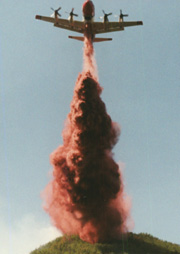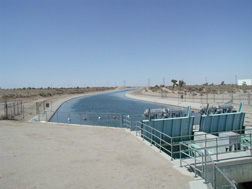2002 Drought Affects Much of Nation
Utahns are not alone, as many parts of the United States suffer from the 2001-2002 drought
October 9, 2002
|
Water conservation has been in the forefront in dealing with the fourth year of less than normal precipitation and particularly poor snowpack in many of the state’s water basins. On April 24, 2002, the Governor declared a severe drought emergency and a statewide agricultural disaster. The southern part of the state has been hardest hit. Urban water users were asked to conserve water by reducing outside irrigation of lawns and gardens. Everyone was requested not to water between the hours of 10 a.m. and 6 p.m.
In Salt Lake City’s water service area, Mayor Rocky Anderson and County Mayor Nancy Workman signed a joint resolution on May 29 asking city and county water users to reduce their overall water consumption by 10 percent and outside watering by 20 percent. With the drought and projected growth demands, the goals of water conservation are two fold: to deal with the drought and develop a water conservation ethic into the future. Currently, Salt Lake City is studying its water rate structure. A Public Utilities Advisory Committee Water Rate Subcommittee has been impaneled to study and recommend changes to the city’s water rates. This initiative, along with a recently completed “Water Efficiency Report,” will provide the tools necessary to structurally change water-use practices.
Utahns are not alone in dealing with drought. Forty-seven states are experiencing some form of water shortage this year. Water problems are spread throughout the continental United States, including the normally water-rich eastern seaboard. Wells have dried up in Virginia, Kansas farmers and ranchers have suffered crop and stock losses and the city council of Santa Fe, New Mexico is considering a plan to limit growth due to the drought. According to NOAA the summer was warmer and drier than average in the United States. The average temperature was the warmest since the 1930s. Global average temperatures were the third warmest on record for the June-August season. Wildfires have burned over 6.7 millions of acres of forestland, double the average. Nationally it is estimated that the drought has caused losses in the neighborhood of $20 billion.
Colorado, Utah’s next door neighbor has been particularly hit hard by the drought. Nearly every segment of the state’s population has been severely affected. Water conservation requirements have affected both urban and rural residents. Wildfires have burned large areas of the state’s forest. Beginning in October, outside turf watering in Denver was banned. During the summer months outside watering was restricted to twice a week. Recently the Denver Broncos’ stadium owners were cited for not complying with lawn watering restrictions and were told that they would have to follow the same watering rules as other Denver citizens. Denver is currently considering tapping the ground water aquifer to develop additional water for a growing population.
The City of Fort Collins receives it water from the Poudre River. If the projected flows for 2002 are correct, this year the river will have the lowest annual flow in recorded history with flows that are only 27 percent of average. Mandatory water restrictions prohibit outside watering Monday through Thursday and residents can only water one day between Friday and Sunday according to their address number. Fines between $50 and $1,000 can be levied for violation of the rules.
The extent of the drought can be measured by the declining flows into the Colorado River over the past three years. The total unregulated inflow into Lake Powell in water year 2000 was 62 percent of normal, while in water year 2001 it dropped to 59 percent. This water year the inflow is expected to be about 24 percent of normal. This downward trend could affect downstream water users and power generation for years to come.
In southern California, Los Angeles received only 4.4 inches of rain, which is 29 percent of normal from July 1 to June 30. San Diego received 3 inches, just 30 percent of normal. Besides water supply for the large population, the potential for wildfires has greatly increased. In the Angeles and San Bernardino national forests, bark beetles have weakened pine trees leaving them susceptible to fire. For the most part the urban areas have not been severely affected by the drought. The Colorado River and the State Water Project are currently meeting the municipal water requirements of southern California communities. However, the drought can only further exasperate water issues
|
As summer has ended and fall begins, the water situation has improved in some part of the country. In Utah September storms helped reduce the demand on reservoirs. However, water conservation is still necessary to protect against another year of drought and further efforts to develop a sound water conservation ethic. From now on, developing good water conservation habits will be part of our daily lives.

